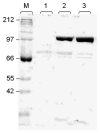Photocaged t7 RNA polymerase for the light activation of transcription and gene function in pro- and eukaryotic cells
- PMID: 20301166
- PMCID: PMC3762680
- DOI: 10.1002/cbic.201000041
Photocaged t7 RNA polymerase for the light activation of transcription and gene function in pro- and eukaryotic cells
Abstract
A light-activatable bacteriophage T7 RNA polymerase (T7RNAP) has been generated through the site-specific introduction of a photocaged tyrosine residue at the crucial position Tyr639 within the active site of the enzyme. The photocaged tyrosine disrupts polymerase activity by blocking the incoming nucleotide from reaching the active site of the enzyme. However, a brief irradiation with nonphototoxic UV light of 365 nm removes the ortho-nitrobenzyl caging group from Tyr639 and restores the RNA polymerase activity of T7RNAP. The complete orthogonality of T7RNAP to all endogenous RNA polymerases in pro- and eukaryotic systems allowed for the photochemical activation of gene expression in bacterial and mammalian cells. Specifically, E. coli cells were engineered to produce photocaged T7RNAP in the presence of a GFP reporter gene under the control of a T7 promoter. UV irradiation of these cells led to the spatiotemporal activation of GFP expression. In an analogous fashion, caged T7RNAP was transfected into human embryonic kidney (HEK293T) cells. Irradiation with UV light led to the activation of T7RNAP, thereby inducing RNA polymerization and expression of a luciferase reporter gene in tissue culture. The ability to achieve spatiotemporal regulation of orthogonal RNA synthesis enables the precise dissection and manipulation of a wide range of cellular events, including gene function.
Figures







Similar articles
-
Genetically encoded light-activated transcription for spatiotemporal control of gene expression and gene silencing in mammalian cells.J Am Chem Soc. 2013 Sep 11;135(36):13433-9. doi: 10.1021/ja4051026. Epub 2013 Aug 27. J Am Chem Soc. 2013. PMID: 23931657 Free PMC article.
-
Building an Inducible T7 RNA Polymerase/T7 Promoter Circuit in Synechocystis sp. PCC6803.ACS Synth Biol. 2019 Apr 19;8(4):655-660. doi: 10.1021/acssynbio.8b00515. Epub 2019 Apr 3. ACS Synth Biol. 2019. PMID: 30935196
-
Structural basis for initiation of transcription from an RNA polymerase-promoter complex.Nature. 1999 May 6;399(6731):80-3. doi: 10.1038/19999. Nature. 1999. PMID: 10331394
-
Innovations, Challenges and Future Directions of T7RNA Polymerase in Microbial Cell Factories.ACS Synth Biol. 2025 May 16;14(5):1381-1396. doi: 10.1021/acssynbio.5c00139. Epub 2025 Apr 10. ACS Synth Biol. 2025. PMID: 40209062 Free PMC article. Review.
-
The highly efficient T7 RNA polymerase: A wonder macromolecule in biological realm.Int J Biol Macromol. 2018 Oct 15;118(Pt A):49-56. doi: 10.1016/j.ijbiomac.2018.05.198. Epub 2018 May 27. Int J Biol Macromol. 2018. PMID: 29847782 Review.
Cited by
-
Recent advances in the optical control of protein function through genetic code expansion.Curr Opin Chem Biol. 2018 Oct;46:99-107. doi: 10.1016/j.cbpa.2018.07.011. Epub 2018 Jul 26. Curr Opin Chem Biol. 2018. PMID: 30056281 Free PMC article. Review.
-
Engineering of enzymes using non-natural amino acids.Biosci Rep. 2022 Aug 31;42(8):BSR20220168. doi: 10.1042/BSR20220168. Biosci Rep. 2022. PMID: 35856922 Free PMC article. Review.
-
Applications of genetic code expansion technology in eukaryotes.Protein Cell. 2024 May 7;15(5):331-363. doi: 10.1093/procel/pwad051. Protein Cell. 2024. PMID: 37847216 Free PMC article. Review.
-
Photocontrolling the Enantioselectivity of a Phosphotriesterase via Incorporation of a Light-Responsive Unnatural Amino Acid.JACS Au. 2025 Feb 5;5(2):858-870. doi: 10.1021/jacsau.4c01106. eCollection 2025 Feb 24. JACS Au. 2025. PMID: 40017780 Free PMC article.
-
Light-Activated Gene Expression System Using a Caging-Group-Free Photoactivatable Dye.Angew Chem Int Ed Engl. 2025 Jan 21;64(4):e202416420. doi: 10.1002/anie.202416420. Epub 2024 Nov 16. Angew Chem Int Ed Engl. 2025. PMID: 39444190 Free PMC article.
References
-
- Cramer P. BioEssays. 2002;24:724–729. - PubMed
-
- Deiters A. Chem Bio Chem. 2010;11:47–53. - PMC - PubMed
- Deiters A. Curr Opin Chem Biol. 2009;13:678–686. - PMC - PubMed
- Lee HM, Larson DR, Lawrence DS. ACS Chem Biol. 2009;4:409–427. - PMC - PubMed
- Casey JP, Blidner RA, Monroe WT. Mol Pharm. 2009;6:669–685. - PubMed
- Young DD, Deiters A. Org Biomol Chem. 2007;5:999–1005. - PubMed
- Tang X, Dmochowski IJ. Mol Biosyst. 2007;3:100–110. - PubMed
- Mayer G, Heckel A. Angew Chem. 2006;118:5020–5042.
- Angew Chem Int Ed. 2006;45:4900–4921. - PubMed
-
- Edwards WF, Young DD, Deiters A. ACS Chem Biol. 2009;4:441–445. - PubMed
Publication types
MeSH terms
Substances
Grants and funding
LinkOut - more resources
Full Text Sources
Other Literature Sources

